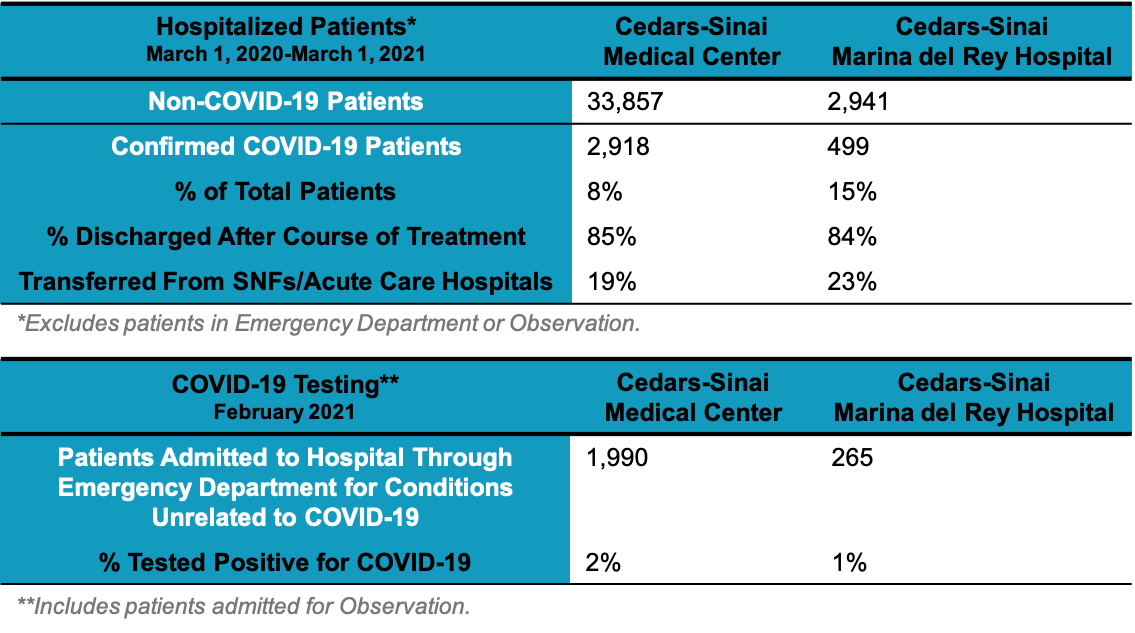#YearofCOVID: Impact, Outcomes for Patients
Data Reflecting Clinical Impact at Cedars-Sinai Hospitals
Hospitals across the country have faced dual pressures over the last year—responding to rising numbers of seriously ill COVID-19 patients while simultaneously caring for many members of the community with cancer, heart disease and other urgent medical needs.
Confronting demands on both fronts, hospitals have been forced to operate above their bed capacities and quickly retrain staff to fill the most immediate needs in intensive care units and other care in high demand.
Cedars-Sinai has grappled with these twin pressures at its two hospitals from the earliest days of the pandemic. Over the past 12 months, staff at Cedars-Sinai Medical Center and Cedars-Sinai Marina del Rey Hospital have provided complex care to nearly 3,500 severely ill COVID-19 patients, enrolling many in clinical trials for experimental therapies. Staff have shifted into new roles as one surge after another brought unexpected challenges that led to innovations in ICU care. All the while, the hospitals treated nearly 37,000 inpatients who needed care unrelated to COVID-19.
The collective efforts have enabled the hospitals to deliver strong results while maintaining capacity to care for those with pressing healthcare challenges.
"Through the relentless efforts of our physicians, nurses, pharmacists, respiratory therapists, environmental services workers and administrative staff, Cedars-Sinai has continued to provide the highest-quality care during an unprecedented and often frightening year," said Jeffrey A. Smith, MD, JD, MMM, executive vice president of Hospital Operations and chief operating officer of Cedars-Sinai.
Strong Results for Patients
Cedars-Sinai began tracking COVID-19 numbers last March as the pandemic erupted. Since that time, 85% of COVID-19 patients admitted to the medical center and 84% admitted to Marina del Rey Hospital have been discharged to continue their recuperation. By comparison, an estimated 80% of COVID-19 patients in the U.S. have been discharged after hospitalization, according to a recent study published in JAMA Network Open.
In the face of an unyielding pandemic, staff at Cedars-Sinai have pivoted and innovated repeatedly to find solutions for patients. Staff, for example, honed their ability to prone patients—turning them over on their stomachs, which allows the lungs to expand more fully and increase the body's oxygen supply. Clinicians swiftly enrolled patients in clinical trials for promising experimental therapies, such as the antiviral drug remdesivir and monoclonal antibody therapy. A team of heart specialists formed to take over the time-consuming but vital job of inserting specialized catheters in the sickest COVID-19 patients to help free up ICU staff to focus on patient care.
Flexibility also was a critical ingredient. Cedars-Sinai redeployed more than 1,200 staff members from across the health system to help where they were needed most: expanding ICUs, and screening and testing patients for COVID-19.
"We achieved our outcomes thanks in part to our outstanding medical staff, who have extensive experience treating complex cases and worked to quickly identify treatments that were helping our colleagues in hot spots around the world," said Richard V. Riggs, MD, senior vice president of Medical Affairs and chief medical officer of Cedars-Sinai.
In Marina del Rey, Cedars-Sinai's smaller community hospital shifted staff and resources to accommodate nearly 500 hospitalized COVID-19 patients, 15% of all admitted patients during the past year.
"I am in awe of the incredible strength, courage and commitment that our staff have demonstrated during the pandemic," said Joanne Laguna-Kennedy, MSN, RN, vice president of Hospital Operations and chief nursing officer of Cedars-Sinai Marina del Rey Hospital. "Not only have they been dedicated to our patients but to each other as well. They have carried each other during this time."
Treating More Than COVID-19
Cedars-Sinai also worked to avoid a second public health crisis by safely providing care to those in the community who needed it.
Over the past year, Cedars-Sinai Medical Center treated nearly 34,000 non-COVID-19 patients, which accounted for 92% of all inpatients. Medical staff performed more than 24,000 medically necessary surgeries and more than 500 transplants, including 128 heart transplants—a new single-year U.S. record. They delivered more than 6,000 babies in 2020 and helped patients manage conditions such as diabetes and cancer. This occurred even as the medical center paused many surgeries in the spring, and again more recently, in anticipation of COVID-19 patient surges.
Staff kept all those patients safe by observing a number of precautions, such as wearing masks, physical distancing and limiting visitors. Testing also played a key role in safety. From March 1, 2020 to March 1, 2021, the medical center administered more than 30,000 pre-procedure tests and Marina del Rey Hospital administered more than 1,700 tests. Cedars-Sinai also helped patients get the care they needed from home whenever possible, providing about 312,000 virtual visits over video or the phone over the past year, compared to about 930 the previous year.
"Cedars-Sinai has always strived to be a blessing to the community," Smith said. "Our staff have truly embodied that spirit during the pandemic."
Read more on the Cedars-Sinai Blog: Going to the Doctor During COVID-19 | What You Need to Know
About #YearofCOVID
One year has passed since stay-at-home orders went into effect across the U.S. and the COVID-19 pandemic changed our lives in profound ways. The novel coronavirus has infected more than 100 million worldwide and killed more than 2.5 million, including more than 500,000 in the U.S alone. It has separated many from their loved ones and cost others their jobs, their homes and their life savings.
But in a dark year, we’ve also witnessed courageous patients and heroic healthcare workers battling the disease, as swift scientific breakthroughs have brought us vaccines and hope.
During March, the Cedars-Sinai Newsroom team is marking this one-year pandemic milestone with a series reflecting on the past 12 months as experienced by our patients, healthcare workers, researchers and community. Follow and join the conversation on social media @CedarsSinai.





